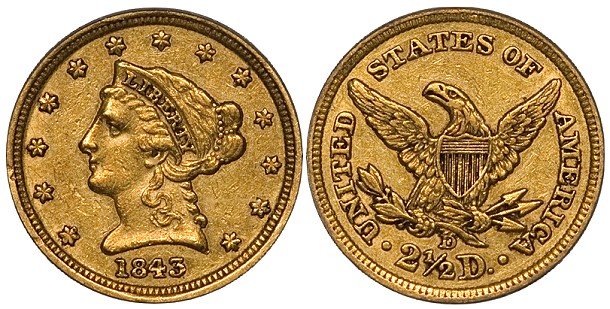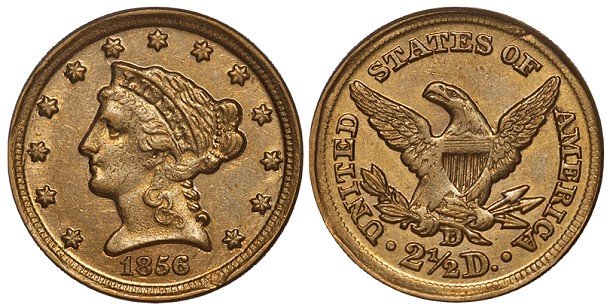By Doug Winter – RareGoldcoins.com
CoinWeek Content Partner ………………..
It is interesting to study the grade distribution patterns for various branch mint gold issues. By this, I am referring to what percentage of a certain issue’s survivors exist in a specific grade range. In order to apply this to a practical numismatic situation, I am going to use the Dahlonega quarter eagle series as my lab experiment. Any assumption that I make in this blog is series specific.
 By this, I mean that what applies to Dahlonega quarter eagles doesn’t apply to New Orleans half eagles or San Francisco eagles. And within the Dahlonega quarter eagle series there are differences; as an example the issues from the 1840’s are likely to have different grade distribution patterns than those from the 1850’s due to a number of factors.
By this, I mean that what applies to Dahlonega quarter eagles doesn’t apply to New Orleans half eagles or San Francisco eagles. And within the Dahlonega quarter eagle series there are differences; as an example the issues from the 1840’s are likely to have different grade distribution patterns than those from the 1850’s due to a number of factors.
In the case of Dahlonega quarter eagles, the primary consideration is that of usage: these coins circulated differently in the 1840’s than they did in the 1850’s.
The 1843-D Small D Quarter Eagle
I think the best “base line” Dahlonega quarter eagle to use in our brief study is the 1843-D Small D. This is the most common date in this series both in terms of overall and high grade rarity. It has the highest mintage figure of any quarter eagle from this mint, and with over 500 examples known, it can be found in a variety of grades.

According to the most recent data from PCGS, there have been a total of 243 coins graded. This number, of course, is inflated by resubmissions, but it gives a good indication of the grade distribution for this issue. According to PCGS, the grade distribution is as follows:
VF and lower: 58 coins (23.86%)
EF: 77 coins (31.68%)
AU: 97 coins (39.91%)
Uncirculated: 11 coins (4.52%)
Before analyzing this, there are a few things to remember. First, there are probably more raw low grade 1843-D quarter eagles than there are high grade ones, meaning that the number at the low end of the grading scale could easily inflate if these were ever submitted. Secondly, the number of coins in very high grades (in this case AU58 and Mint State) is clearly inflated on account of the financial incentive to upgrade a coin. An upgrade from VF25 to VF30 is pretty meaningless, but an upgrade from AU55 to MS60 translates to a not inconsiderable amount of money. And lastly, the grade range that has seen the most gradeflation in the last decade is AU, meaning that a significant number of coins graded AU50 or even AU53 by PCGS would not necessarily qualify as such if broken out and submitted again.
Taking all of these caveats into consideration, this grade distribution makes sense to me. I expected at least 60-70% of all 1843-D quarter eagles to grade EF45 and below, and according to PCGS’s figures, the current percentage is 55.54%. If we were able to dismiss all the superfluous AU submissions included in the numbers above, and punt all the marginal AU50 coins that are actually EF’s, this figure might well be close to 70%.
I think that the actual number of 1843-D quarter eagles which grade AU is more likely in the 25-30% range; not all that far off from the 39.91% figure shown.
By any stretch of the imagination, Uncirculated 1843-D quarter eagles are rare. My best estimate is that 15-20 are known, and many are marginal MS60 to MS61 examples. In MS62 and MS63 there are likely no more than four to six and none finer.
The grade distribution for the 1843-D Small D quarter eagle is reasonably similar to that seen for the 1844-D, 1845-D, 1846-D, 1847-D, and 1848-D. These are six of the most available quarter eagles from this mint and they represent the Golden Age, if you will, of commercial use for this denomination in the antebellum south. Beginning in 1848, gold discoveries in California made the Dahlonega (and Charlotte) mint redundant, and by 1854, mintage figures of all C and D mint denominations except half eagles were cursory at best.
The 1857-D Quarter Eagle
There is a Dahlonega quarter eagle whose grade distribution is complete different than the 1843-D; enough so to be a complete anomaly within the series. This is the 1857-D; let’s look at the PCGS figures.

A total of 70 1857-D quarter eagles have been graded by PCGS. The by-grade breakdown is as follows:
VF and lower: 4 coins (5.71%)
EF: 6 coins (8.57%)
AU: 45 coins (64.28%)
Uncirculated: 15 coins (21.42%)
The 1857-D is the second to last quarter eagle from this mint with an original mintage of only 2,364 with an estimated 125-150 known. As long as I have specialized in Dahlonega coins, I’ve noted that the 1857-D is almost never seen in VF or EF grades, and most of the survivors are in the AU53 to AU58 range.
What is most interesting about this date is that so many of the survivors have a similar look. The typical example in AU55 to AU58 has an “Unc-ish” appearance with many of the hallmarks of a Mint State coin but with either light friction or soft hairlines suggestive or a gentle old cleaning. And, on most of the high grade coins, the color and quality of luster are similar.
These facts combined with the PCGS grade distribution lead me to believe that the 1857-D is a hoard coin. I can’t prove this—and even if it is true I know nothing specific about the so-called hoard. But the fact that 85% of all 1857-D quarter eagles graded by PCGS are AU or Uncirculated is interesting and is completely different in pattern than for any other date in this series.
The 1856-D Quarter Eagle
There is one final Dahlonega quarter eagle with a grade distribution pattern which varies from the norm but for a different reason.

The 1856-D is not only the rarest quarter eagle from this mint; it is the rarest single issue of any denomination. Only 874 were struck and around 45-55 are known in all grades.
The distribution by grade is very interesting; let’s take a quick peek at how the PCGS has graded the 35 they have recorded:
VF and lower: 5 (14.28%)
EF: 8 (22.85%)
AU: 21 (60%)
Uncirculated: 1 (2.85%)
There are many interesting things about these numbers, but two points need to be mentioned first. The 1856-D is an extremely poorly produced coin which is exceptionally hard to grade. I have seen 1856-D quarter eagles which could be graded VF30 just as easily as they could be graded AU50. It is also important to remember that as a rarity within the series, PCGS (and NGC as well) tend to push the grade on the 1856-D quarter eagle. Because it is such a rare coin, a nice EF45 example is typically graded AU50 or AU53 with little complaint from specialists.
I think the PCGS grade distribution for the 1856-D is skewed way too far towards AU and I very, very seriously doubt if “60%” of all known examples grade AU50 to AU58. But given the difficulty of grading this issue, I can understand how this is the case.
As I mentioned at the beginning of this blog, the grade distribution for each series depends on a number of factors. Age and the original mintage figure are obvious and important, but there are less subtle factors at play such as perceived rarity, appearance of the coin, whether or not a hoard exist(ed), and if examples were expatriated to Europe and are now returning to the American market.
Do you buy rare gold coins?
Do you have coins to sell?
Would you like to have the world’s leading expert with you assembling a set of coins?
Contact Doug Winter at (214) 675-9897 or by email at [email protected].
About Doug Winter
 Doug has spent much of his life in the field of numismatics; beginning collecting coins at the age of seven, and by the time he was ten years old, buying and selling coins at conventions in the New York City area.
Doug has spent much of his life in the field of numismatics; beginning collecting coins at the age of seven, and by the time he was ten years old, buying and selling coins at conventions in the New York City area.
In 1989, he founded Douglas Winter Numismatics, and his firm specializes in buying and selling choice and rare United States coins, especially US gold coins and all branch mint material.
Recognized as one of the leading specialized numismatic firms, Doug is an award winning author of over a dozen numismatic books and the recognized expert on US Gold. His knowledge and exceptional eye for properly graded and original coins has made him one of the most respected figures in the numismatic community and a sought after dealer by collectors and investors looking for professional personalized service, a select inventory of impeccable quality and fair and honest pricing. Doug is also a major buyer of all US coins and is always looking to purchase collections both large and small. He can be reached at 214-675-9897.
Doug has been a contributor to the Guidebook of United States Coins (also known as the “Redbook”) since 1983, Walter Breen’s Encyclopedia of United States and Colonial Coins, Q. David Bowers’ Encyclopedia of United States Silver Dollars and Andrew Pollock’s United States Pattern and Related Issues
In addition he has authored 13 books on US Gold coins including:
- Gold Coins of the New Orleans Mint: 1839-1909
- Gold Coins of the Carson City Mint: 1870 – 1893
- Gold Coins of the Charlotte Mint: 1838-1861
- Gold Coins of the Dahlonega Mint 1838-1861
- The United States $3 Gold Pieces 1854-1889
- Carson City Gold Coinage 1870-1893: A Rarity and Condition Census Update
- An Insider’s Guide to Collecting Type One Double Eagles
- The Connoisseur’s Guide to United States Gold Coins
- A Collector’s Guide To Indian Head Quarter Eagles
- The Acadiana Collection of New Orleans Coinage
- Type Three Double Eagles, 1877-1907: A Numismatic History and Analysis
- Gold Coins of the Dahlonega Mint, 1838-1861: A Numismatic History and Analysis
- Type Two Double Eagles, 1866-1876: A Numismatic History and Analysis
Finally Doug is a member of virtually every major numismatic organization, professional trade group and major coin association in the US.
If you are interested in buying or selling classic US coins or if you would like to have the world’s leading expert work with you assembling a set of coins? Contact Doug Winter at (214) 675-9897 or by email at [email protected].




